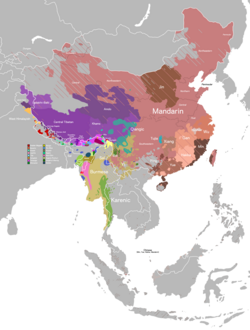External links
Wikivoyage has a phrasebook for Amdo Tibetan .
Wikibooks has a book on the topic of: Research on Tibetan Languages: A Bibliography
- The Tibetan Phrasebook - A Phrasebook of Modern Amdo Tibetan
- A Bibliography of Tibetan Linguistics
- A Week in Rebkong, Amdo, an Amdo primer
- AHP43 Amdo Tibetan Language
Sino-Tibetan branches | |||||
|---|---|---|---|---|---|
| Western Himalayas (Himachal, Uttarakhand, Nepal, Sikkim) |
| ||||
| Eastern Himalayas (Tibet, Bhutan, Arunachal) | |||||
| Myanmar and Indo- Burmese border |
| ||||
| East and Southeast Asia |
| ||||
| Dubious (possible isolates) (Arunachal) |
| ||||
| Proposed groupings | |||||
| Proto-languages | |||||
Italics indicates single languages that are also considered to be separate branches. | |||||
| West Himalayish (Kanauric) |
| ||||||||||||||||||||||||||||
|---|---|---|---|---|---|---|---|---|---|---|---|---|---|---|---|---|---|---|---|---|---|---|---|---|---|---|---|---|---|
| Bodish |
| ||||||||||||||||||||||||||||
| Tamangic |
| ||||||||||||||||||||||||||||
| Official | |||||||||||||||||||||||||||||||||||||||||||||||||||||||||
|---|---|---|---|---|---|---|---|---|---|---|---|---|---|---|---|---|---|---|---|---|---|---|---|---|---|---|---|---|---|---|---|---|---|---|---|---|---|---|---|---|---|---|---|---|---|---|---|---|---|---|---|---|---|---|---|---|---|
| Regional |
| ||||||||||||||||||||||||||||||||||||||||||||||||||||||||
| Indigenous |
| ||||||||||||||||||||||||||||||||||||||||||||||||||||||||
| Minority | |||||||||||||||||||||||||||||||||||||||||||||||||||||||||
| Varieties of Chinese | |||||||||||||||||||||||||||||||||||||||||||||||||||||||||
| Creole/Mixed | |||||||||||||||||||||||||||||||||||||||||||||||||||||||||
| Extinct | |||||||||||||||||||||||||||||||||||||||||||||||||||||||||
| Sign | |||||||||||||||||||||||||||||||||||||||||||||||||||||||||
| |||||||||||||||||||||||||||||||||||||||||||||||||||||||||
Tibetan language | |
|---|---|
| Language | |
| Scripts |
|
| Others |
|
| Tibetic languages outside Tibetan plateau | |
| Authority control databases: National |
|---|
